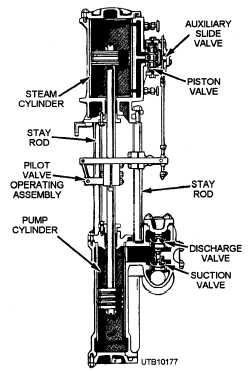each stroke displaces a definite quantity of liquid, regardless of the resistance against which the pump is operating.
The standard way of designating the size of a reciprocating pump is by giving three dimensions, in the following order:
1. The diameter of the steam piston
2. The diameter of the pump plunger
3. The length of the stroke
For example, a 12- by 11- by 18-inch-reciprocating pump has a steam piston 12 inches in diameter, a pump plunger 11 inches in diameter, and a stroke of 18 inches. The designation enables you to tell immediately whether the pump is a high-pressure or low-pressure pump.
TYPES OF RECIPROCATING PUMPS. - Reciprocating pumps are usually classified as follows:
Direct acting or indirect acting
Simplex (single) or duplex (double)
Single acting or double acting
High pressure or low pressure
Vertical or horizontal
The reciprocating pumps used by the Navy are usually one of the following types-direct-acting, simplex, double-acting, or vertical. The types most often used are direct acting pumps. The pump shown in figure 6-12 is direct acting because the pump rod is a DIRECT extension of the piston rod; and, therefore, the piston in the power end is DIRECTLY connected to the plunger in the liquid end. In an indirect-acting pump, there is some intermediate mechanism between the piston and pump plunger. The intermediate mechanism may be a lever or a cam. This arrangement can be used to change the relative length of strokes of piston and plunger or to vary the relative speed between piston and plunger. Or the pump may use a rotating crankshaft, such as a chemical proportioning pump in a distilling unit.
The diaphragm pump shown in figure 6-13 is a direct-acting reciprocating pump. It is commonly used by Utilitiesman to pump water from a ditch or sump.
Diaphragm pumps use a flexible diaphragm to move the liquid. The prime mover is usually a small gasoline or diesel engine with an eccentric connecting rod arrangement that converts rotary motion to reciprocating motion. On the suction stroke, the

Figure 6-12. - Reciprocating pump.
diaphragm is drawn upward into a concave configuration. This movement of the diaphragm results in a partial vacuum that causes the suction ball valve to unseat (and at the same time keeps the discharge ball valve seated) and to admit the liquid to the pump cylinder. On the discharge stroke, the diaphragm is pushed downward, forcing the trapped liquid out through the discharge valve. Thus the liquid is made to move by the reciprocating motion of a flexible diaphragm.
Since the diaphragm forms an almost perfect seal in the pump cylinder between the liquid being pumped and the rest of the pump and driving mechanism, there is some danger of liquid abrasion or corrosion of moving parts behind the diaphragm. For this reason, diaphragm pumps are especially reliable for pumping mud, slime, silt, and other wastes or heavy liquids containing debris, such as sticks, stones, or rags. Liquid strainers are fitted at the suction inlet to prevent large objects from fouling the suction and discharge valves or from damaging the diaphragm.
You can use the diaphragm pump for dewatering trenches where sewer lines or waterlines are to be laid or for repairing breaks in waterlines or sewer lines.
Two of the most popular types of diaphragm pumps are the mud hog (closed discharge) and the water hog (open discharge). The MUD HOG is for
Continue Reading